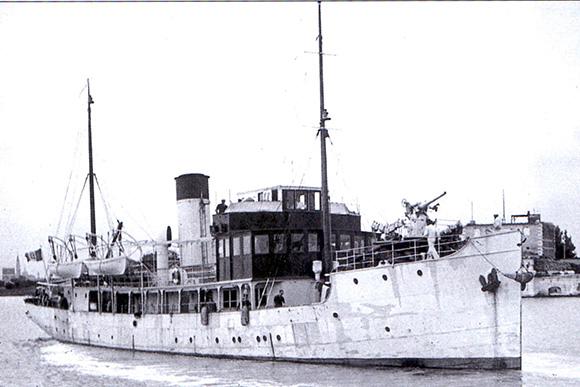Ships have a name and a soul. Often the three things (ship, name and soul) coincide. A famous case is that of St. George, a veteran of all the Italian wars since the entry into service, in the 1910, to the defense of Tobruch in the 1940-1941. Books, articles and documentaries were dedicated to that ship, from then until today. In theory, therefore, everything is known about St. George. However, one piece is missing. A small detail of just 364 tons of tonnage.
The name St. George it was in fact brought, in those years, also by a steamship of the Società Anonima di Navigazione a Steam Istria launched in 1914 and registered, from 12 May 1940, in the roles of the State Auxiliary Naviglio with the characteristic F. such a patron could not be limited to the very dignified tasks of piloting.
And indeed, here in April 1941, given the lack, or almost, of Italian warships in the Upper Adriatic at the time of the war with Yugoslavia, our lookout passes in the front line with its forward cannon from 57 / 43 (it was a piece of the 1887, an obviously excellent vintage for cannons). Embarking, from a good vaporetto, a platoon from landing of sailors, ours went to occupy, shooting here and there when it was necessary, more than an island in Dalmatia for two weeks in a row. In the 1942 he then became a minelayer, embarking on a dozen weapons at a time to be laid, between a patrol and the other, in the canals of the archipelago. Dangerous craft, certainly, but no more than that of many other ships and their men of those times or during every war. This at least, until 17.25 of the 18 February 1943.
At that moment, as recorded in the Diary of Supermarina, someone in the Operations Room (the progenitor of the current CINCNAV, in Santa Rosa) believed he had misunderstood. The message, transmitted in the clear, said "Spotted and attacked the enemy, San Giorgio ship fights". The old cruiser had sunk more than two years ago. A few minutes later, another marconigram followed, previously transmitted in code and just deciphered: “45 ° 02N 13 ° 35 E (south of Cape Promontore, in Istria, ed.) Attacked by Smg. with the launch of a torpedo that passes under the hull without exploding. Depth bomb throwing ". There were only 4 bombs available, but the reaction of the Italian ship launched at full speed (in truth, 10 knots) going up the wake of the torpedo had been rapid and precise. Spotted the thin attack periscope, the St. George 3 threw that target at the target. Shortly after the opposing boat, English Thunderbolt, emerged. In the mission report of the British commander it is stated that he launched, from less than 500 meters, against a corvette. As a promotion on the pitch, it wasn't bad for that steamer. The British news then affirms that the submarine, subjected to the enemy anti-submarine fighter, emerged to "attack" the Italian ship. Too bad that the initial distance between the two ships was 5.500 yards and then climbed, in the course of a quarter of an hour, to over 8.000 between the boat that was spinning at 17 knots and the vaporetto that was pursuing it at, yes and no, 11 producing a great black smoke with his old coal-fired triple expansion machine and the stokers shoveling and sweating like hell. The proportions between the English boat, from 1.326 tons and 84 meters long overall, and the 38 meters of the St. George they were the same as Commander Ahab's spear against Moby Dick.
The duel between the English 102 mm gun, which fired 66 grenades in response to the Italian 57's fire (32 shells fired in that phase) did not produce reciprocal damage, as the Italian mission report immediately and honestly pointed out. The British wrote, however, that they had scored several hits on the target, probably deceived by the thick cloud of smoke that came out of the ship's funnel. Finally, fixed the minor failures reported while submerged, the Thunderbolt, as the light was going down (due to the failing light) and being now in an area of sufficient depths, he thought well of diving and moving away. Probably the spirit of Saint George, the patron saint of Genoa, did not want to rage.
Il Thunderbolt was then sunk, the 12 March 1943, in front of Capo San Vito, in Sicily, from the Italian corvette Stork. St. George continued its war in the Adriatic. Naufragò, during a violent storm, the 12 February 1944 at the mouth of the Po. Recovered after the end of the conflict, it resumed sailing under the usual civilian clothes of an honest mixed cargo ship with an unexpected past. The saint, as always a sailor in pectore, then passed his hand to a handsome fighter pilot who entered service in the 1955 and, in the 1987, to the current amphibious assault ship. There is little to do: the motto Arremba San Zorzo it is a question of soul, ship and holy warrior, all together at all times and in all ages, without question of size.












